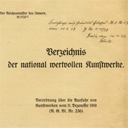0287 Export Regulations and the Role of Ancient Objects in the German List of Nationally Important Artworks
Identifiers (Article)
Abstract
The paper provides a brief overview of art export regulations in the Mediterranean region from the 19th century to the laws adopted in the 1920s and 1930s. It then focuses on the German law of 1919 requiring works of art that were predominantly privately owned and of outstanding value to be entered in a register, the so-called List of Nationally Important Artworks. Once the works were listed in this index, they were subject to authorization for export. Despite the high importance the National Socialists attributed to Greek and Roman art as an eternal art, only one percent of the artworks that were classified as nationally valuable were from ancient periods. The instrumentalization of the export regulation through the National Socialist regime is illustrated by the example of Albert Lévy’s collection of antiquities in Hamburg. For provenance research, it is essential to determine how laws were extended, applied, bypassed, or overruled during National Socialism and, thus, instrumentalized as a means of state power.
Statistics

License

This work is licensed under a Creative Commons Attribution-NonCommercial-NoDerivatives 4.0 International License.




